ISSN ONLINE(2320-9801) PRINT (2320-9798)
ISSN ONLINE(2320-9801) PRINT (2320-9798)
| B.Sahayapriya1, S.Sivakumar2 Electronics and Communication engineering, SSIET, Coimbatore, Tamilnadu, India |
| Related article at Pubmed, Scholar Google |
Visit for more related articles at International Journal of Innovative Research in Computer and Communication Engineering
On road vehicle detection is the main problem for some applications such as driver assistance systems, autonomous and self-guided vehicles.Vehicle or non vehicle classification is the important issue in the case of vehicle detection, Gabor filters are having good performance in this case. Feature extraction and edge detection are performed to do this vehicle or non vehicle classification. Support vector machine classifiers are used to do this feature extraction. Vehicle detection algorithms are mainly having two stages, one is hypothesis generation and another one is hypothesis verification. Hypothesis generation is nothing but the quick search on the potential location of the vehicle in the image. Hypothesis verification stage is used to verify the correctness of the vehicle candidates provided by the previous stage. And also in this paper we propose accuracy of Gabor filter as a function several parameters such as number of scales, minimum wavelength, adaptable wavelength and also the number of orientations.
Keywords |
| Gabor filter, Hypothesis generation, hypothesis verification, Feature extraction, Edge detection. |
INTRODUCTION |
| In general self-guided vehicles are the main reason for most of the accidents, due to this atleast one person dies in every minute. To avoid this, advance driver assistance systems (ADAS) take more precautions for road safety. Vehicle detection helps ADAS to avoidaccidents.According to this; the interest on vehicle detection based image analysis gets increaseddue to its low cost, flexibility and processing capabilities. The main objective of this work is to detect the vehicle using Gabor filter. Another one objective is vehicle detection in the high traffic intensity areas during automatic traffic control. Vehicle detection based image analysis mainly involves two classifications thatare; the object shown in the image is vehicle or non vehicle. This classification can be done with the help of twosteps, one is hypothesis generation another one is hypothesis verification. |
| Hypothesis generation is nothing but the quick search on the potential location of the image. And the aim of the hypothesis verification is, to verify the correctness of the vehicle candidates provided by the hypothesis generation. To detect any vehicle edge detection and feature extraction are the important two stages. Feature extraction can be done with a help of a Gabor filter bank at different scales and orientations. In this work a bank of 8 Gabor filters with 2 different wavelengths and 4 different orientations is used. The support vector machine classifiers are used for feature extraction. The SVM classifiers are used to classify the needed set of information from the training set of data. Edge detection is nothing but calculating the number of pixels in the edges or boundaries which are used to differentiate two objects in the in the image. This edge detection is highly helps in the case of vehicle or non vehicle identification. Edge detection is used to eliminate any discontinuity in image it will provide the set of connected curves that indicate the boundaries of objects. So with the help of filtering the sharp edges obtained from the edge detection are get smoothen. |
RELATED WORKS |
| The active sensors are most commonly used method for vehicle detection. The active sensors are mainly based on three categories they are radar-based method (i.e., millimeter-wave) laser-based method(i.e., lidar), and acoustic-based method. In the radar based method the radio waves are transmitted into the atmosphere, which scatters some power back to the receiver of radar. From the received radio waves the vehicle or non vehicle identification is concluded. The laser-based method is also called as lidar method. The meaning for lidar method is light detection and ranging. In this lidar method the electromagnetic radiations are transmit and receive but they are operate in the higher frequency. |
| The passive sensors also implemented in the field of vehicle detection. These passive sensors also called as the optical sensors. They are similar to that of normal cameras.The passive sensors are inexpensive when compared to active sensors. They have a ability to cover the vehicle in the forward and backward direction with the help of inexpensive cameras. It will provide the good visual information without requiring any modification to road infrastructures. |
| Kalman filter plays an important role in the vehicle detection approach. The Kalman filters are mainly used in the three dimensional based vehicle tracking. The extended Kalman filter and Kalman filters are mostly used in the visual tracking system. These filters are commonly comes under the category of linear recursive filters.Motion tracking will make use of the extended Kalman filter. The performance of EKF is more accurate due to the addition of a new object function. The control system diagnosis also uses the same object function. By using this model parameter is addressed. After the matching of model parameter with the real system, the orthogonal condition for the EFK is satisfied. This Kalman filters are helpful in visual traffic surveillance system. That is it smoothly track the vehicle in traffic scenes and analyse the behaviour of vehicle. But this model only suitable for the gray scale image and in bad weather condition it will not give the good performance. |
PROPOSED SYSTEM |
| The main focus of this work is on improving the performance of vehicle detection by employing a Gabor filter. A critical issue when perform the vehicle detection is vehicle classification. Specifically, the work propose a systematic and general Gabor filter approach for optimizing the parameters of a set of Gabor filters in the context of vehicle detection. The vehicle classification involves two particular stages; one is hypothesis generation and hypothesis verification. Hypothesis generation involves three methods they are; knowledge based method, stereo based method and motion based method. The first method should have clear knowledge about the vehicle in the image. This method is mainly based on some features, such as symmetry, colour, corners and horizontal edges. |
| The stereo based method involves two important things for vehicle detection; one is disparity map and Inverse perspective mapping. The distinct in left and right images between corresponding pixels is called disparity. This can be identified by using the disparity map. IPM identifies the left image corresponding to world coordinate and project them back on to right image. The third method concentrates on the difference between vehicles and background. The hypothesis verification involves the processing of information obtained from the hypothesis generation. It will depend upon two steps; temple based method and appearance based method. The first step will use the predefined patterns of vehicle and perform correlation between the image and temple. The appearance method will done the vehicle and non vehicle classification. |
| Prior to defining the Gabor descriptors, let us make some considerations related to the filtering process. Naturally, the input space is discrete, therefore in order to transfer the image (of size R×C) and the filter to the frequency domain, the Discrete Fourier Transform (DFT) is required. Gabor energy features (which combine the response of symmetric and anti symmetric Gabor filter) are thus selected. These features result in very large vectors (as large as the size of the image) and thus entail heavy training and classification. Therefore, statistical moments are usually preferred and will also be adopted. In particular, three moments are analysed: the mean, μ, the standard deviation, σ, and the skewness, γ, of the data distribution, |
| Gabor-filter based descriptor is analysed as a function of several parameters. This represents the state of the art in the use of this technique for the vehicle verification task. Regarding the classification procedure, the feature vector extracted for the descriptors is fed to a Support Vector Machine (SVM) classifier. These classifiers are extensively used in the related literature owing to their good generalization, and have been reported to deliver better performance than other traditional methods. |
| The basic block diagram of a Gabor filter is shown in Fig 3.1, it will have the four blocks they are: Gabor prefilter, magnitude operator, Gaussian postfilter, segmentation. |
 |
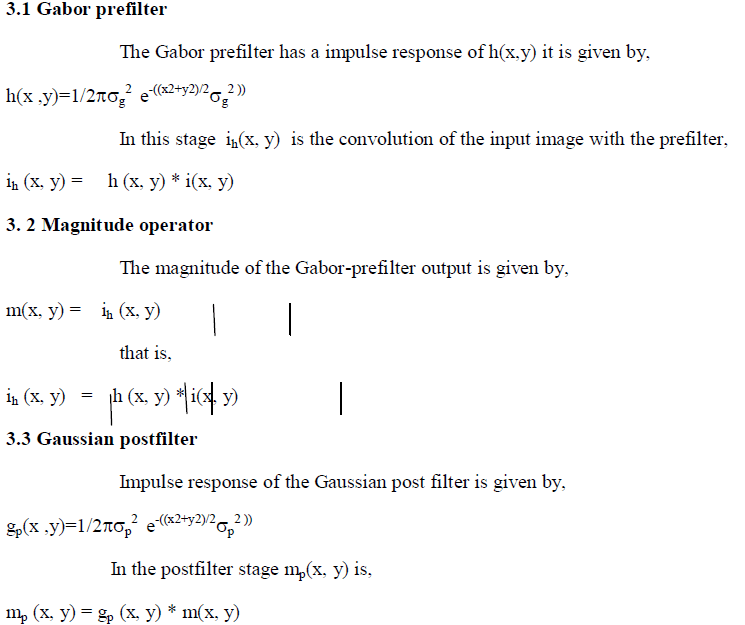 |
3.4 Segmentation |
| Threshold is selected depending on minimum segmented error based on the estimated probability density function .In this support vector machine classifier is used for multilevel segmentation. |
RESULT ANALYSIS |
| A set of simulations have been performed on the GTI vehicle database to derive the combination of parameters of the Gabor filter bank that yields best vehicle classification performance. The filtered image in the input space is eventually obtained by applying the Inverse DFT (IDFT) to the product of the image and the filter in the frequency domain. |
| For vehicle, |
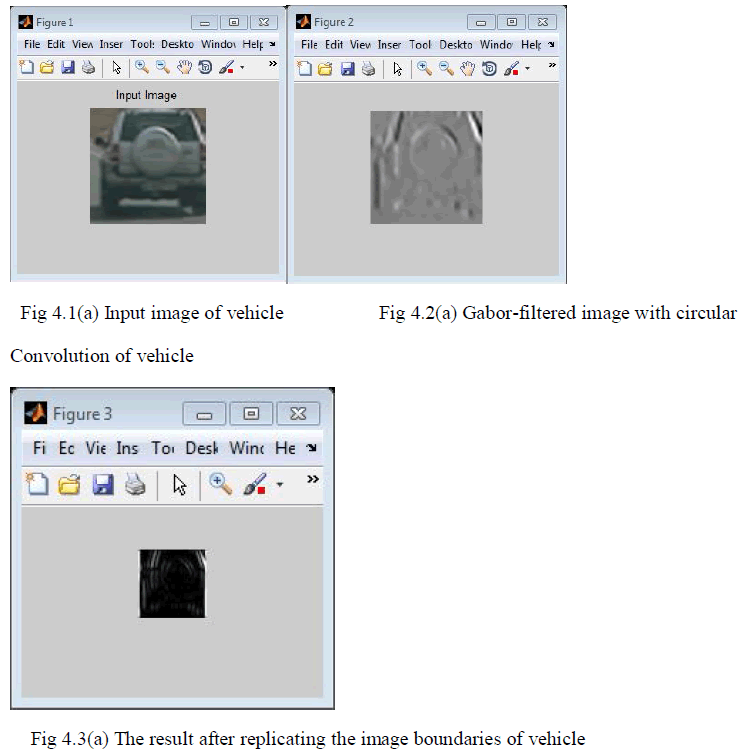 |
| Fig 4.1(a) Original image.Fig 4.2(a) Gabor-filtered image with circular convolution. Observe the artifacts produced in the image boundaries due to luminance discontinuity. Fig 4.3(a) the result after replicating the image boundaries prior to filtering (the image is cropped to the size of the original image), in which artifacts have been removed. |
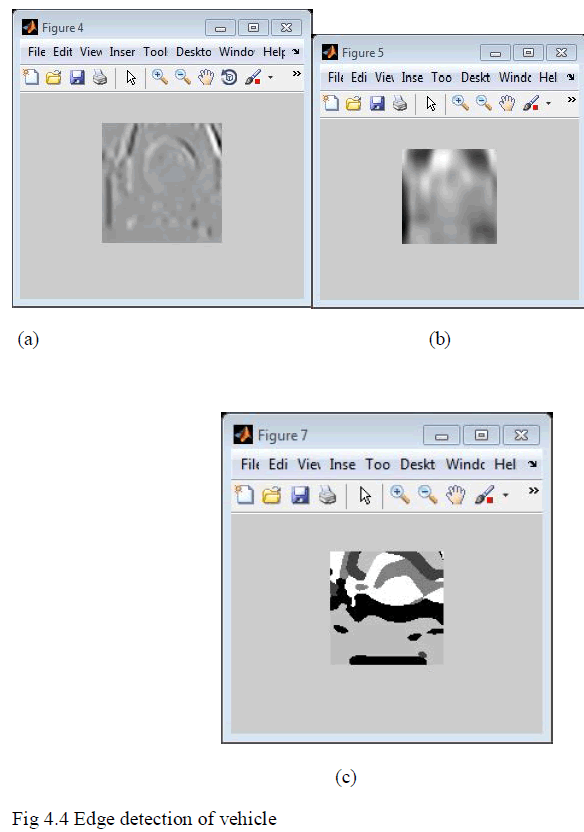 |
| Fig 4.4 is the output images of edge detection operation of vehicle which is done after the circular convolution using Gabor filter.The accuracy of gabor filter as function of number of scale is shown below, |
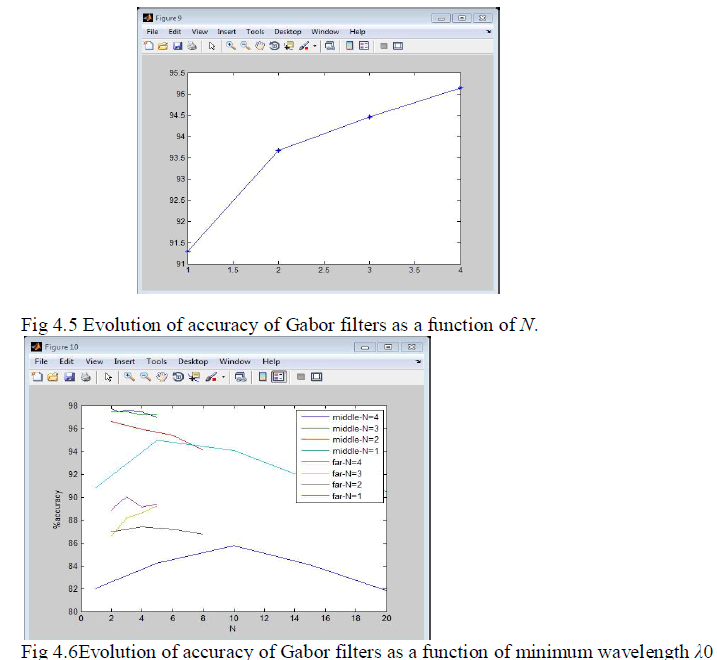 |
| Fig 4.6 shows the close/middle range has been computed as the average of the front, left, and right rates. As expected, the solid lines corresponding to the close/middle range have their maximum at a lower λ0 than their dual dashed lines at the far range for all values of N. |
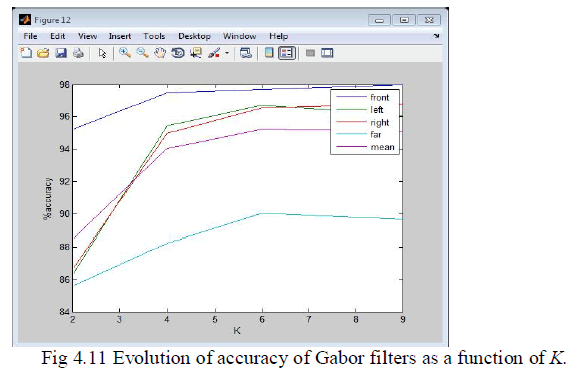 |
| Fig: 4.7 show the Evolution of accuracy of Gabor filters as a function of K for the various image regions. The red line will show the average evaluation in the figure. Here only the vertical and horizontal orientations are taken. |
CONCLUSION |
| Robust and reliable vehicle detection is the main problem for some applications such as driver assistance systems, autonomous and self-guided vehicles. On-road vehicle detection is having vehicle and nonvehicle classification problem.Gabor filters have been reported to show good performance in this problem. Gabor filtergive more information from the images than the other filters. The Gabor filters are having more accuracy as a function of number of scales, number of orientations and also the wavelength. Gabor filters are suitable for both colour image and also the gray scale image. In the bad weather condition also it will perform well. |
FUTURE ENHANCEMENT |
| Gabor functions have a number of drawbacks relating to their frequency response. The main contribution is the proposal and evaluation of a new descriptor based on the alternative family of log-Gabor functions for vehicle detection, as opposed to existing Gabor filter-based descriptors. These filters are more accurate than Gabor filters as they can better represent the frequency properties of natural images. |
References |
|